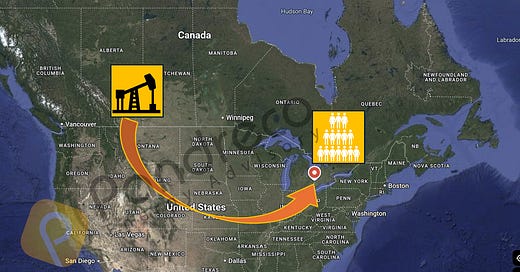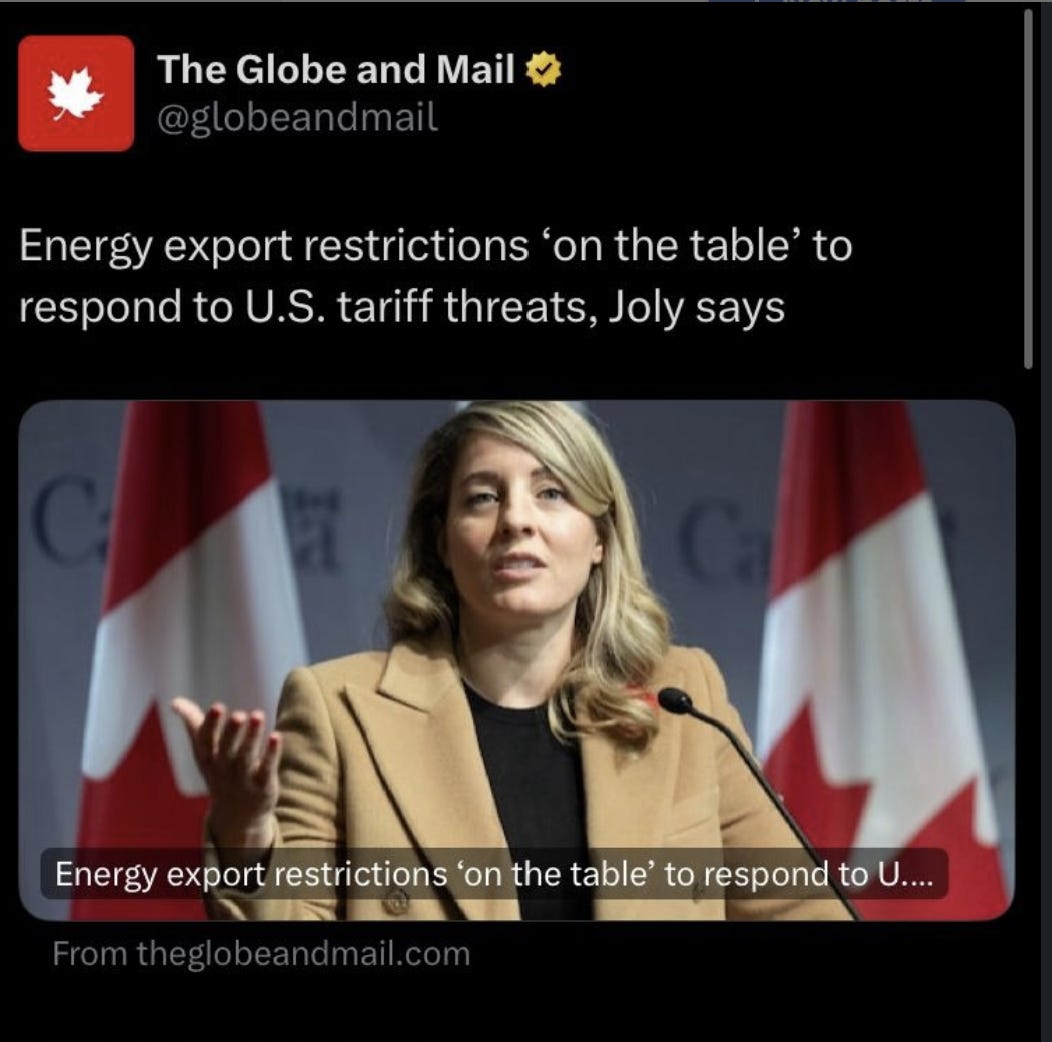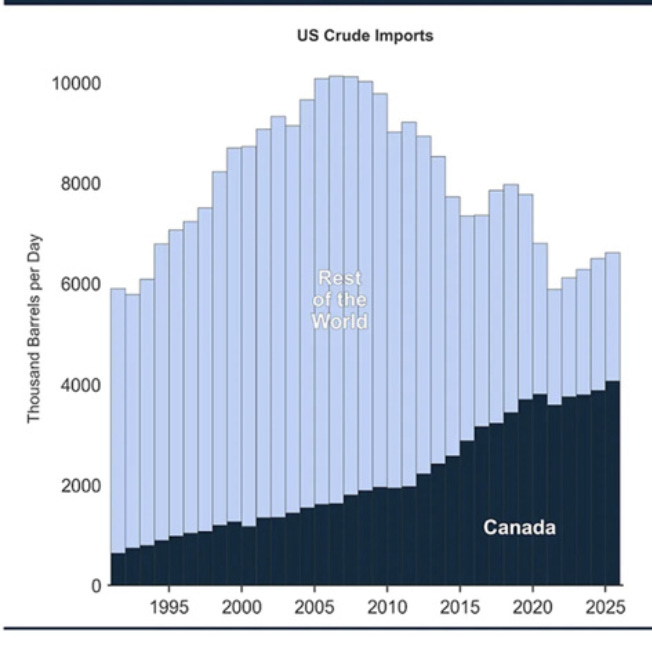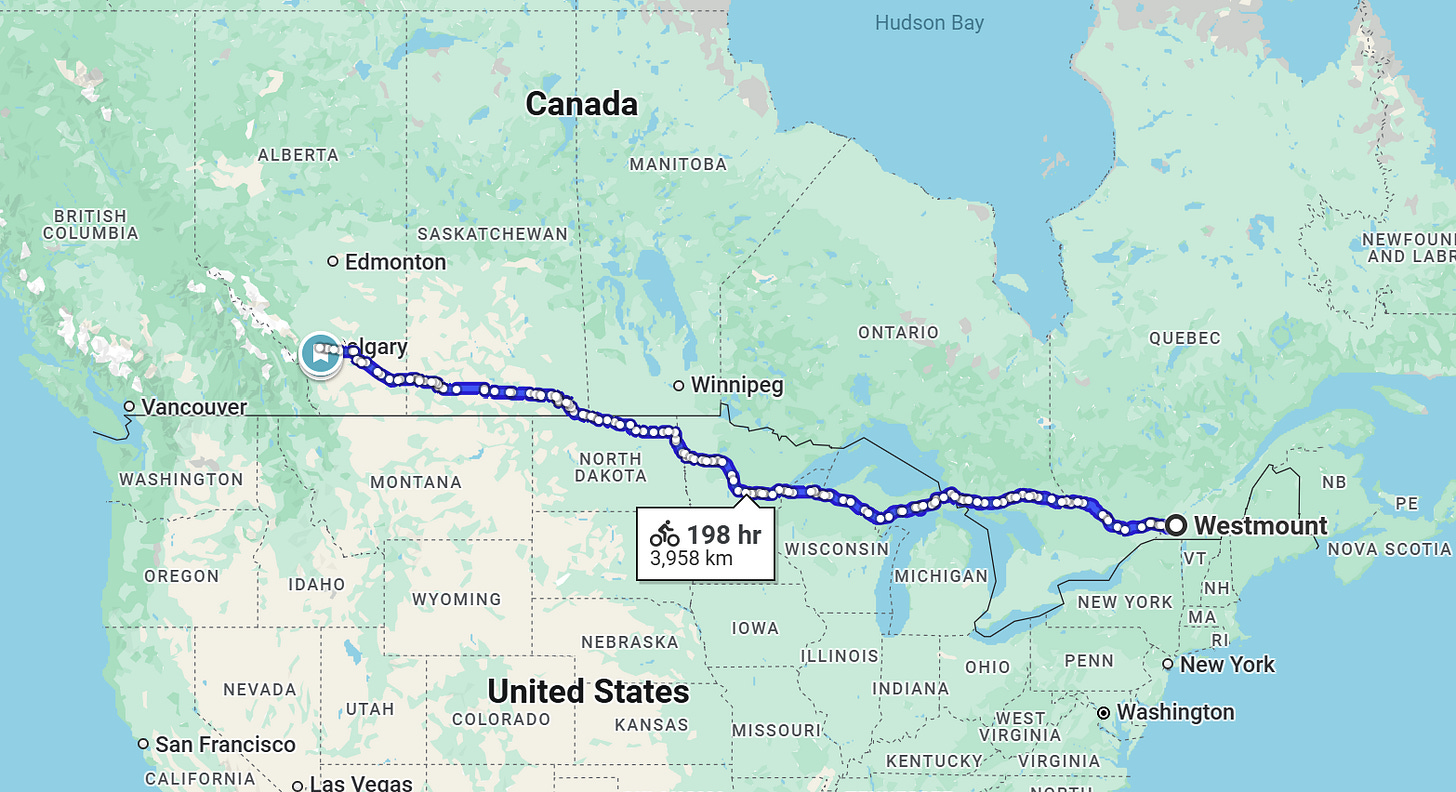Retaliation - a MAD policy?
What would "retaliation" look like if Canada cut off energy exports?
In the shock and awe of the “Great February 3rd Trade War”, President Trump threatened 25% tariffs on Canadian products. Ottawa took the bait and started talking about “retaliation”.
“What I can tell you is everything is on the table,” Joly said, asked specifically whether the government prepared to cut off energy exports south of the border. (ctvnews)
Retaliation from a position of weakness is an empty threat - the weakness is not just about potential damage to Alberta’s oil industry, the fact that the Provinces have jurisdiction over natural resources, or the hypocitical “One Canada” approach - its about keeping people alive in the GTA and Quebec1.
Turn the taps off in Western Canada and Ontario and Quebec will run out of fuel faster than you can say “Where’s my Poutine"?”2
The Line In The Sand
The 49th parallel is the straight line that separates the four western Canadian provinces from our southern neighbour. It then gets a bit wiggly around the Great Lakes and up the St Laurence - and is a lot less neat between New Brunswick and Maine.
Fun fact, most Canadians live south of the 49th, most resources are north of it. The political split may appear to be East-West (or indeed South-North), but the polarization is more about understanding energy systems, or not.
Trump’s Tariffs Part 2
In a long line of bad ideas… retaliation seems to be one of the worst. I “get” the sentiment behind all of the “a bully only respects strength” aphorisms, but I genuinely don’t think that retaliation is the first port of call, especially when you are in a weak position3. Maybe getting out of that weak position should be priority Number 1 - even if it is not an immediate fix.
Now that we have a few weeks of breathing space, maybe we can take stock? To understand what “retaliation” would look like - we need to think about existing infrastructure.
Canada is a net exporter of oil and gas to the US, and we are also a net exporter electricity to the US. Indeed, these are part of the “issue” of the imbalanced trade account that apparently irks Trump4. But note that in both cases we are “net” exporters.
This is particularly significant for oil. We are probably familiar with the fact that Canada is now by far the biggest source of imported crude into the US. The heavy Canadian crude is increasingly important because:
The Mid West refineries in PADD2 and PADD4 are designed to use these grades - retooling refineries is a massive financial and time commitment, and are geographically isolated from the Gulf coast import terminals. The arterial pipelines are to Canada. This is what Ottawa sees as its leverage.
The extraordinary growth in US “oil” production from shale has always been very light oil - and is increasingly very light - much of it is in the form of Natural Gas Liquids5 - which are much less energy dense than crude oil (see Art Berman’s Blog for more on this). This increases the need for heavy crudes to mix in so the blend can be refined and/or exported.
One of the complexities of the cross-border trade is that US exports of crude and of refined products not only need Canadian crude, but actually creates value for the US economy from both. Canadian crude trades as WCS - there is always a quality-discount (because it is heavy), and frequently there is “demand” discount. Crude in Alberta is essentially stranded by lack of pipelines to global export markets6 and as such is a price-taker. The US refineries and blenders have massively benefitted from this.
Canada Imports Oil
Pretty odd given that we are the 4th largest oil producer, and 3rd biggest oil exporter in the world. Production in 2024 was c. 5 mmbbls/day, with 4.3 mmbbls/day going to the US. So why in the world would Canada import oil?
The answer is a combination of geography and politics. I may have mentioned this before, but Canada is very big. Shocking I know. In addition to the distances, E-W “linear” projects are very challenging due to geography: mountains, rivers, lakes, forests. And then there is provincial politics…
Interestingly, the proposed Google Maps route for my commute to work would take me through the USA. This is an unintended, but useful segue into the pipeline network.
Mutually Assured Destruction
Just as my hypothetical cycle commute takes a US detour, Canadian oil moves to the popultaion centers of Ontario and Quebec via pipelines in the USA. The most infamous of which is Line 5.
The Line 5 pipeline, which crosses Michigan's Straits of Mackinac, became a flashpoint under Michigan’s Governor Gretchen Whitmer's administration due to concerns about environmental risks to the Great Lakes. In November 2020, Whitmer revoked the pipeline's 1953 easement, setting a shutdown deadline for May 2021, citing the pipeline's vulnerability to spills and its age as reasons for immediate action.
Would that it be that simple. I’m reliably informed that Michigan gets cold in winter, and a lot of people rely on propane for heating.
Line 5 carries a mix of light crude oil, light synthetic crude, and other petroleum products. It's estimated to transport up to 540,000 barrels per day (bpd) of these products. The majority of this crude oil originates from western Canada and the Bakken shale in North Dakota. About 30% of Line 5’s volume, or approximately 162,000 bpd, is delivered to refineries in Michigan (Marathon's Detroit refinery) and Ohio, with the remainder crossing into Canada - notably the Sarnia refinery in southern Ontario as well as on-routing to the Suncor refinery in Montreal.
In addition, propane from the Line 5 NGLs processed in Sarnia (ON. Canada) is sent back to Michigan through a separate pipeline system, contributing significantly to the state's propane supply.
Michigan gets almost all of its propane - an essential fuel for winter heating directly from Line 5, or indirectly after redistribution of Line 5 products back from Sarnia. Imagine what this “win” would look like if the G’vnor had actually shut the pipeline on the grounds of a possible future environmental risk?
Michigan households would have had a cold winter - but what of Ontario and Quebec?
"When you begin a journey of revenge, start by digging two graves: one for your enemy, and one for yourself."
Let’s now consider the scenario whereby Ottawa convinces AB and SK to halt exports to the US as “retaliation” to tariffs.
The lights would (probably) stay on - electricity in Ontario is hydro (55%), nuclear (24%) and some gas (13%) and “others”. Quebec is 98% hydro, so is pretty secure. Ontario might have some issues with 13% of its electricity coming from gas - which is piped from the US. That 13% is typically “peaker” plants that operate when supply is tight - not what you want to have under threat.
Whilst electricity is probably manageable, propane for heating, and refined products (gasoline, diesel, jet-fuel) for transport, would last a few days at most. Quebec would last a bit longer - it is so “cut off” from Western Canada that oil is imported from the Atlantic basin to Quebec City and refined at Lévis at the 265,000 bbl/d Jean Gaulin Refinery.
West-East Pipe Dreams
Maybe Trump has done us a huge favour by pointing out our self-inflicted weakness? As Heather Exner-Pirot of the MacDonald-Laurier Institute has noted - Canada should be an energy super-power. For sure our geography is challenging, particularly for E-W projects, but ultimately policy can "trump" geography. The "post-national state" is starting to (re)find its core identity thanks to threats of annexation and/or tariffs. Maybe this is what Trump is all about - waking the woke?

The logic for a trans-national West-East Pipeline (along with more West→Pacific options) has been brought into sharp relief by the threat of tariffs. To avoid being a commercial hostage to the US market, exporting crude to the Pacific and Atlantic markets would be a critical step in increasing Canada’s economic independence. In practical terms, the Western Canadian basins could supply the US and the global markets if the egress infrastructure were in place.
The less obvious consequence of new West-East infrastructure would be much greater energy-security for the huge population centers in Ontario and Quebec.
The less obvious consequence of new East-West infrastructure would be much greater energy-security for the huge population centers in Ontario and Quebec.
I have no idea where the Trump tariffs will end up (see some thoughts linked in the footnotes). What is certain is that we now have uncertainty. Maybe things will go back to “business as usual”, maybe a 10% tariff, who knows?
In four years we may have MAGA continuity or a reversal - who knows?
But we now know that Energy Security works best when you are autonomous. Imagine that: relying on your neighbours is not a safe bet - no matter how allied and aligned you think you are.
Can we learn this lesson and act accordingly?
As a resident of Quebec, I am kind of vested!
In this post I’m only looking at oil and NGLs. The use of exported electricity as a bargaining chip is another interesting topic… for another day. Poutine is not an export commodity.
I wrote a bit about the mutual dependency between Canadian producers and Mid-West Refiners here
The New ERA tour - Trump's Trade Tariffs
In the New Era of Trump’s trade tariffs, tariffs trump trade.
I will write “Trump” rather than “President Trump” simply because I am lazy… this is a convention, not a commentary of any kind. “Obama”, “Bush”, “Reagan” etc were all acceptable.
The TMX expansion has helped reduce this effect somewhat











Good outline of how oil flows in Canada, its important that more people in Canada understand the current state of affairs.